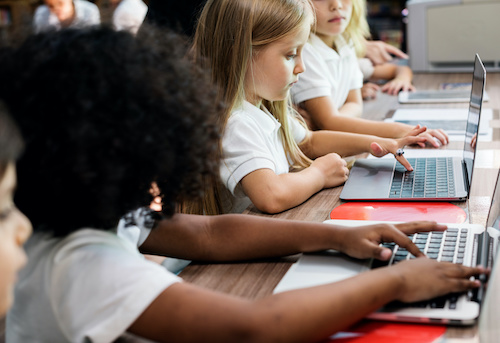Key points:
- The science of reading can and should guide curriculum design
- Efficacy research evaluates how faithfully teachers use literacy programs and the outcomes students achieve
- See related article: 4 big benefits of professional development for adolescent reading instruction
- For more news on literacy, visit eSN’s Innovative Teaching page
Prior to the pandemic, reading achievement had been showing little to no growth in the National Assessment of Educational Progress data. Scores have continued to decline, in part because of pandemic-related learning interruptions. In short, it has never been more critical to understand how to support students on the path to reading proficiency by the end of 3rd grade.
Applying research to practice is at the core of instruction based in the science of reading. The science can and should guide curriculum design. Efficacy research is a proven method of evaluating instructional delivery decisions so teachers, parents, administrators, and students understand what practices and resources connect directly with gains in literacy achievement.
The efficacy research at Reading Horizons evaluates the fidelity with which teachers use their programs and the outcomes students achieve when programs are implemented as designed. Their research program encompasses studies with a wide variety of school districts, to ensure that their data reflects our nation’s student population and teachers’ levels of training and instructional approaches.
An introductory look at the data
According to Dr. Stephanie Myers, vice president of impact and research for Reading Horizons, their current research program investigated U.S. school districts that have adopted Reading Horizons Discovery, their foundational literacy curriculum for grades K–3. During the 2021-2022 school year, they conducted research with four districts in four states, using third-party assessments to measure student outcomes. They focused their research in five distinct areas:
- Effective communication to support the Reading Horizons method for foundational literacy, with teachers providing students with a clear, concise lesson summary and the concepts covered prior to the lesson to ensure students connect new and existing skills;
- Use of the curriculum’s embedded instructional routines including dictation routines, and demonstration by students that they understand the information they were learning on their own and in collaboration with classmates;
- Asking students targeted questions to monitor learning in real time as the lesson progresses;
- Providing feedback that reaches and supports all students; and
- Using the pacing and structure as established in the curriculum to allow an appropriate amount of time for each aspect of the lesson to ensure students reach transfer, defined as their ability to apply the day’s concepts.
What the research said
“Data from the four implementations studied to date are encouraging,” said Myers. “Those teachers observed implementing the curriculum with high degrees of fidelity are seeing the fastest results for their students.” All four districts logged increased growth over the previous year. Students in kindergarten and 1st grade demonstrated greater growth than those in 2nd grade, which could be because these 2nd-graders may have missed essential instructional opportunities connected to pandemic school closures or other disruptions. Some other key findings included:
- The marking system: Within the growing body of data on best practices related to the science of reading, several approaches to teaching the bottom of Scarborough’s Reading Rope have emerged, covering phonological awareness, decoding, and sight recognition for words. This research study and others the company has conducted point to significant gains among learners with teachers who understand and apply a marking system designed to help students learn how to pronounce and build words.
- Multi-sensory learning: A multi-sensory approach is also associated directly with positive research results. Myers said that, “The multi-sensory engagement that comes from using hand motions, reading often during lessons, standing during lessons, and using their voices throughout instruction activates different parts of the brain, leading to greater learning at a more rapid pace.”
- Instructional routines: Data points out that instructional routines may also link to growth. These routines should ensure that all students participate through lessons. A collaborative environment emphasizes peer-to-peer work. The benefits include making student learning transparent for teachers as they monitor students working together and using targeted questions to assess in real time how students interpret and understand the day’s concepts. This observational data informs the feedback teachers provide to students to correct or deepen their thinking.
Using data to inform improvement
The four-district study also pinpointed opportunities to further strengthen literacy instruction using the science of reading. These include more emphasis on supporting teachers as they learn and apply instructional routines. “Predictable lessons, particularly for younger students, help learners focus on the materials they’re learning,” said Myer. “Schools at the beginning of their implementation will benefit from additional help in these routines.”
Reading Horizons’ research also pointed out challenges with pacing: some teachers spent too much time on review, thus slowing the pace of learning. These teachers could benefit from PD guiding them to “make real-time notes and then follow-up with students who may need additional instruction, rather than holding up the whole class.”
Reflecting on the purpose of this and other research, Myers concluded, “It’s more critical than ever that we understand how to teach students to read, and we have all the tools and resources needed to make their journey to literacy as fast and successful as possible. The more we understand what materials work, what conditions matter, and where improvements can make a difference, the more students will learn to read proficiently in less time.”
- Friday 5: Virtual field trips - April 26, 2024
- Google, MIT RAISE launch no-cost AI training course for teachers - April 26, 2024
- 4 ways to support work-based learning - April 23, 2024

